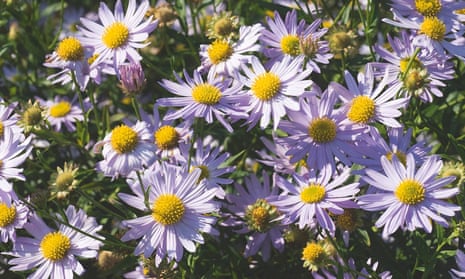Kalimeris, often known as Korean asters, are such unpretentious members of the sunflower family. No one ever writes about them, you rarely hear growers or designers mention them, and even at the nursery it is easy to pass over them for larger, showier-bloomed daisies, such as asters, chrysanthemums or heleniums. I feel this needs to change.
Whereas many asters and chrysanths look well turned out, kalimeris look as if they’ve spent the weekend wild camping. They start flowering in July and, if the soil is moist and the seasons kind, will carry on until October. Their tough stems mean that they don’t need staking and will stand over the winter, fading if not gloriously, then with dignity. In early spring, you can cut them back in time for the new flush of growth.
They grow 40-60cm high in a nice, neat clump that needs dividing only on their fourth or fifth year if you find they are taking up too much room. They can be deadheaded, but there is little point. The flowers fade unobtrusively, simply drying up so another round will appear.
Best of all, they are slug-proof and, unlike asters, never get mildew. Once established, they are also fairly drought-tolerant and fully hardy, and can be grown in sun or part-shade, in any garden soil, though they like a bit of drainage on heavier soils. Their endlessly remontant behaviour makes them a valuable plant for nectar-hungry insects – you will find they are always covered in bees, hoverflies and butterflies.
The flowers are small and daisy-like in white, soft blue and palest lilac. Not strong colours that will necessarily shine in the late slanting light of summer, but that’s beside the point. Their unobtrusive ways are there for others; they combine well everywhere, with grasses, with sedums and Japanese anemones, among ferns and next to cabbages and kales. The lilac and mauve colours look particularly good next to dusky purples. They are tough plants, so work well in pots – just make sure you give them a large enough container to grow into.
There are several species available, mostly through specialist independent nurseries such as Beth Chatto Gardens and the Garden House in Brighton. Kalimeris incisa is the most widely available. It grows to 40-50cm tall and has single pale bluish-white flowers. ‘Blue Star’ is a soft blue, ‘Charlotte’ the palest lilac, and ‘Alba’ pure white. K. mongolica is slightly taller, growing to 60cm, and flowers just that bit longer than K. incisa varieties. K. mongolica ‘Antonia’ has mauve flowers that start in July and go on till October. K. ‘Mon Jardin’ has slightly larger, starry white flowers and grows to 60cm high. K. pinnatifida has semi-double cream-white flowers, so it looks like a tiny chrysanthemum.

Comments (…)
Sign in or create your Guardian account to join the discussion